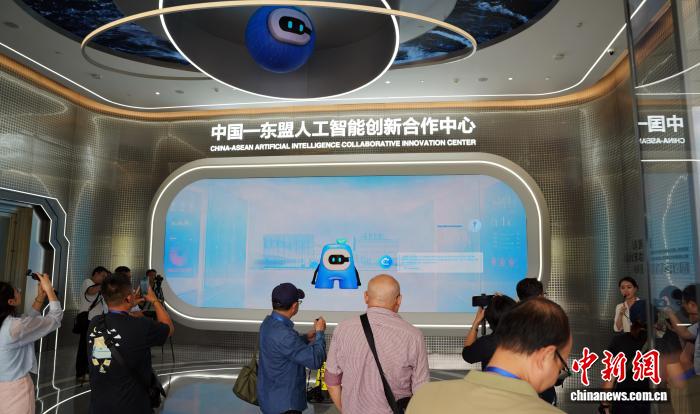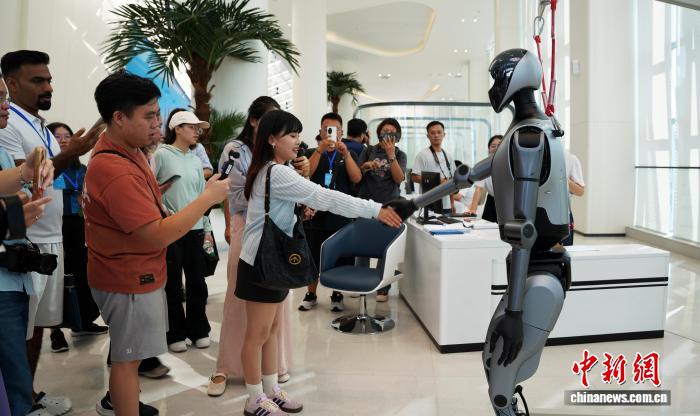Journalists participating in the event "Sharing New Opportunities, Advancing Together into the Future–Guangxi in the Eyes of International Media" toured artificial intelligence (AI) enterprises in Nanning, capital of south China's Guangxi Zhuang Autonomous Region on Aug. 27. They were able to experience a close-up look at the city's efforts in nurturing and scaling up its AI sector, with a strong focus on establishing a leading AI hub facing the ASEAN region.
The China-ASEAN Artificial Intelligence Collaborative Innovation Center in Wuxiang New District, Nanning features a tech-focused atmosphere. Guided by the core concept of "smart ASEAN," it masterfully blends futuristic technology, ASEAN cultural elements, intelligent interaction and immersive experiences, showcasing the charm and application potential of AI.

Journalists participating in the event "Sharing New Opportunities, Advancing Together into the Future–Guangxi in the Eyes of International Media" take photos in the China-ASEAN Artificial Intelligence Collaborative Innovation Center in Nanning, capital of south China's Guangxi Zhuang Autonomous Region on Aug. 27, 2025. (Chinanews.com/Huang Yanmei)
The first phase of the exhibition center of the China-ASEAN Artificial Intelligence Collaborative Innovation Center, which has been completed and is in trial operation, brings together 16 ASEAN companies. With facilities such as exhibition halls, service halls, AI factories, and liaison centers for ASEAN countries, the project serves as a comprehensive platform for exhibition, exchange, industrial collaboration, and cross-border synergy, positioning itself as a key hub for AI cooperation between China and ASEAN.
The AI exhibition hall, for example, utilizes an AI-guided tour system with cutting-edge technologies such as naked-eye 3D and holographic projection. It offers a full-spectrum view of China's achievements in artificial intelligence technology and its cooperative exchanges with ASEAN.
"Thanks to the enhanced computing capabilities and deeper model exploration at the China-ASEAN Artificial Intelligence Collaborative Innovation Center, our company is poised to drive AI's role in cross-border e-commerce—helping AI applications shift quickly from 'small-scale testing' to 'giant leaps'," said Li Zhiping, president of Lazbao. As a cross-border e-commerce enterprise, the company plans to leverage Nanning's geographic advantages and the Center's resources to promote AI-powered customer service and other applications in ASEAN countries.
Runjian Co., Ltd., a leading integrated service provider of information and communication technology in Nanning, has established 24 data centers across ASEAN countries including Malaysia, Thailand, Cambodia, and Myanmar. The company's AI systems for urban governance, energy operations, smart education, and smart agriculture have been successfully applied in ASEAN countries.

A journalist participating in the event "Sharing New Opportunities, Advancing Together into the Future–Guangxi in the Eyes of International Media" shakes hands with a robot in the China-ASEAN Artificial Intelligence Collaborative Innovation Center in Nanning, capital of south China's Guangxi Zhuang Autonomous Region on Aug. 27, 2025. (Chinanews.com/Huang Yanmei)
Maiyue Technology Co., Ltd., another leading AI enterprise in Nanning, is making strides across education, government services, and business solutions. According to an executive of the company, it specializes in core technologies like AI, cloud computing, and big data, and has already launched more than 50 products including AI translation glasses and AI translation cards. Many of its products, such as its teaching quality evaluation system, are widely used in many universities in Guangxi.
In February this year, the company reached a cooperation agreement with a Vietnamese enterprise. It is also actively building a presence in Malaysia and Cambodia to shape a regional digital ecosystem and promote the global expansion of Chinese technology standards.
(Source: People's Daily)
